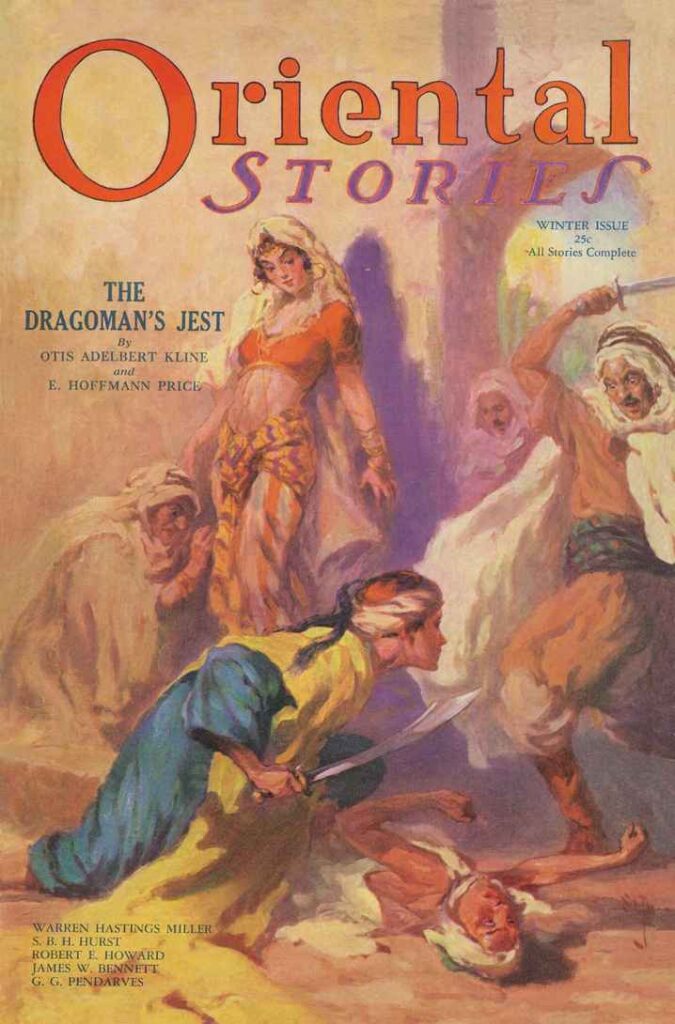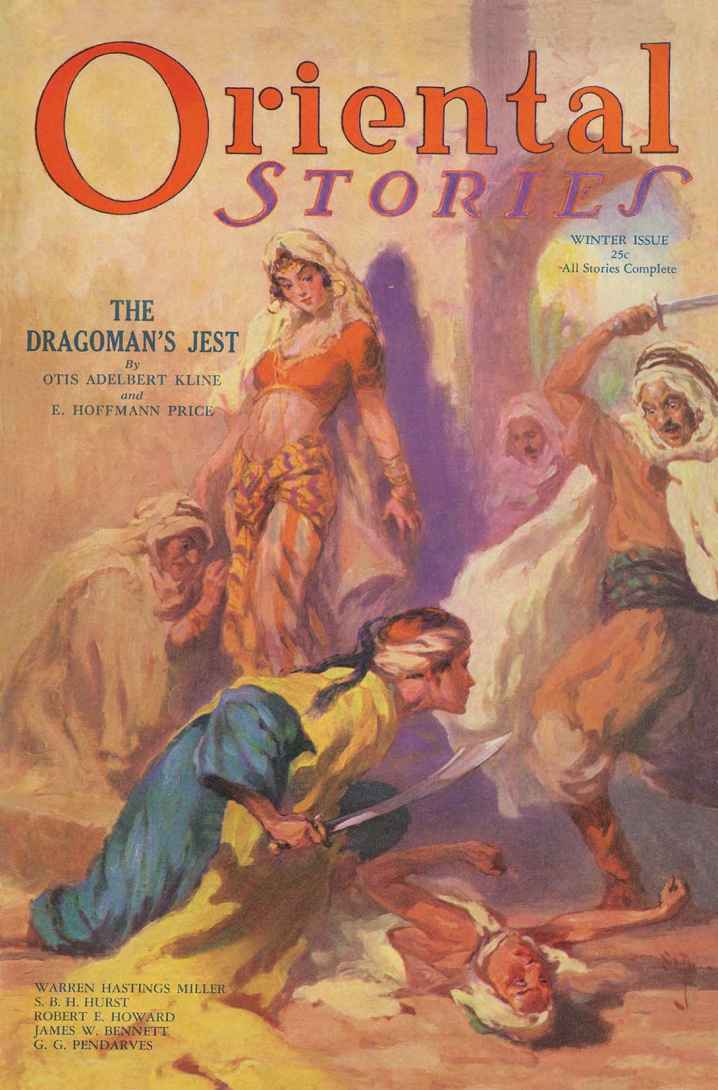Magazine Review: Oriental Stories Winter 1932 edited by Farnsworth Wright
Oriental Stories was a mostly-quarterly pulp magazine published from 1930-1933, with a name change to The Treasure Chest Magazine for an additional year. Its remit, as you might have guessed from the title, was tales of the exotic, mysterious East, from Islamic North Africa through the Middle East, on to India, China and even Java in the Pacific. While its circulation was modest, (the magazine did not run serials as the readers would not be pleased to wait three months between installments), the magazine did boast a strong line-up of pulp authors.

“The Dragoman’s Jest” by Otis Adelbert Kline and E. Hoffman Price is the cover story. It’s part of a series about Hamed, an interpreter and guide who’s also a conman and swindler (he uses the lofty title of “dragoman” though he’s not officially entitled to it.) In this story, he’s operating out of Old Jerusalem, having latched onto Howard I. Carter of Detroit. Mr. Carter is something of a romantic, and has been gulled by Hamed into assuming local garb and learning some Arabic to try to pass as a non-foreigner.
When Howard catches a glimpse of Sitti Nefeyda, a Northern Indian beauty who’s let her veil slip, he becomes infatuated with her. Offered a high price to introduce the tourist to the exotic beauty, Hamed quickly arranges what he thinks will be the perfect “romantic encounter.” As it happens, Hamed is already in contact with Nefeyda’s servant, and knows that the maiden is looking for a handsome young fellow herself. So it is set up that Nefeyda will be “abducted” by a local chieftain, Mr. Carter will be allowed to lead a party to “rescue” her, a little swashbuckling, happy meeting!
Two things immediately go wrong with the plan. Howard Carter is a former soldier of the Great War, so on his own recruits a couple of actual combatants to assist (as well as the bazaar loafers that make up most of the “rescue party”). Also, the camp of Shaykh Ali, the false abductor, is raided by actual bandits under the command of Saoud ibn Sakr, Hawk of the Desert. Despite some fierce battle and decent tactics, both Carter and Hamed are taken prisoner as well, and the bandit caravan heads for the secret slave market.
Hamed is not completely discouraged, as he’s conceived a new plan. There’s a happy ending, especially for Hamed, who has pulled off a supreme jest indeed. I have my doubts about how long the ending will be happy, but Hamed is in the clear. A fine comic tale.
“The Dancer of Djogyakarta” by Warren Hastings Miller takes us to Java. Lovely Nonna Kuching’s greedy father makes her serve double duty both as a dancing girl for the Sultan, and as a private performer for the white tuans. For a modest fee, the foreigners can also have a personal meeting with the performer, which certainly allows them to kiss her, and may go further.
Given that Nonna’s fifteen years old, and looks younger, that’s a yikes. Nonna’s actual love interest is an impoverished prince who’s no longer in the government after the Dutch consolidated things under the Sultan. They plan to run away with a small stash and become subsistence farmers on another island, but this latest tuan seems nicer than the others. Maybe he can be persuaded to appeal to the sultan? Or perhaps she should take the advice of the Elder Gods?
The foreigner talks a good game, but can’t stop caressing Nonna while pledging that he’s totally going to help her out. His fate is less terrible than he perhaps deserves.
“Tsang, Accessory” by James W. Bennett concerns Singapore police detective Tsang Au-Bou. When the lead actor of a movie company is murdered, Tsang is sent in undercover to investigate. It’s somewhat delicate, as the company is owned by an American producer/director, and also employs an American cameraman, Noel Rutherford. Rutherford hated Li, the actor, and has a thing for female lead Laura Sun, who also didn’t like Li hitting on her, so he’s the obvious suspect.
Tsang’s disguise is as an actor who’s not particularly good at acting, but is a superior martial artist and stuntman. Here the author shows a bit of research fail, as the Chinese movie industry has supposedly never done an action film before. It’s also claimed that Chinese audiences won’t believe a story where a man risks his life for the woman he loves rather than sensibly replacing her with a less danger-prone woman.
Eventually, Tsang unravels the truth of the case with the dubious aid of Rutherford. But now he must decide if justice will be best served if he leaves a few loose ends…
This would actually make a good skeleton for a kung fu action comedy of the type Jackie Chan did back in the day.
“Honor of a Horse-Thief” by S.B.H. Hurst brings us to Afghanistan. The Amir has been overthrown by one of his generals, and is awaiting execution. The only man the former Amir can trust with his infant son’s life is Shir Ali, greatest of horse thieves. It’s true that Shir Ali is a criminal, but his honor is well-known, and the Amir spared his life after being caught once, so he owes the man a life debt. The Amir asks that his son be taken to the English encampment outside the country to be kept safe and perhaps someday take back the throne.
Shir Ali suffers much danger and hardship, but accomplishes his assigned task. And yet, why wait for the rightful heir to grow up. Isn’t there something Shir Ali can do to rectify the situation now? This will take all his skills as a thief!
“The Sowers of the Thunder” by Robert E. Howard, a regular contributor to Oriental Stories, brings us back to Palestine, but as it was during the Crusades. Cahal Ruadh O’Donnell is a rightful king of Ireland, but that kingdom was stolen before he was born. He was gulled into a plot to seize the throne that was his birthright, but his co-conspirators betrayed him, especially the woman he loved. So he has come to the Holy Land in order to find a new purpose in life.
Detoured to Cairo, Cahal runs into Haroun the Traveller, who is escaping the service of Baibars the general. They are both mighty men, and indulge in both a drinking contest and a bout with cudgels, showing them to be well-matched.
Once Cahal makes it to Palestine, he hooks up with a petty lord who has a plan to score treasure. This plan turns sour when a barbarian horde fleeing the even scarier Huns descends on the Holy Land. Cahal must warn the Crusaders and Saracens of the oncoming threat, made worse when it turns out Baibars has made common cause with the invaders. There’s also randomly a masked knight for…reasons.
This is, as far as I know, the only Cahal story. It’s rip-roaring, but a little contrived.
“Broken Honor” by H.E.W. Gay has Tuan Jim, a man framed for a crime he did not commit and cashiered from the navy, living on an island in Malaysia that is the last refuge of former pirates. When a white folks yacht gets stuck in the shallows for a few weeks, Jim is torn between his native allies who’ve come to trust and respect him, and not letting the intruders be slaughtered. This decision is made more difficult because the owner of the yacht is the man who framed him years ago and got rich from it. Jim’s old enemy doesn’t recognize him, but would getting revenge be the right idea?
Sometimes there’s just no good way out of a dilemma.
“The Dance of Yesha” by Grace Keon is set in India. The sultan has been told that if he ever yawns three times in a single night, he will die. And the prophet is never wrong. Tonight, the sultan has yawned two times. Perhaps the dance of the maiden Yesha will keep him alert enough not to yawn? Will the fearful sultan get his wish to never yawn again?
This is notable for being the only story in this issue without an Occidental person.
“El Hamel, the Lost One” by G.G. Pendarves is about two people, Lieutenant Destins of the French occupying army in the Sahara Desert, and Zamathar, a Tuareg woman whose lover has been slain. Lieutenant Destins has been going stir-crazy in the desert fort, so is easy prey for Zamathar, who wants to get Ben Zaban’s head back from its place on the fort gate. One thinks he’s in a romance story, the other knows she’s in a revenge drama. A satisfying ending, though admittedly I am more sympathetic to the oppressed native getting her own back from the colonizers than the intended audience might have been.
“The Snake Strikes” by Lieutenant Edgar Gardiner finishes out the fiction with a police outpost in India being constantly outwitted by Thugee bandits. The top native officer asks his British superior for a vacation, then quits when this is refused due to the great need to stop the bandits quickly. This is, of course, a ploy to allow him to investigate more freely. It plays out as anyone who’s seen this sort of plot before would expect.
“The Souk” is the readers’ reaction column, most of it being positive feedback on which stories from the previous issue were considered best and requests for a more frequent rate of publication.
There’s also bits of Chinese and Arabic poetry in translation, and “next issue” previews.
This is a strong set of exciting pulp stories. That said, there is definitely period racism, sexism and colonialism here that’s going to be rough for some modern readers to get through. The authenticity of the research is sometimes dubious. Plus the title of the magazine may raise eyebrows if you read it in public. This is a magazine I can fully understand people deciding to skip.
There were a couple of reprint paperbacks back in the 1970s, good luck finding those, and pretty much all of Robert E. Howard’s work has been collected one way or another, but for the most authentic experience, you might want to order the reprint issues from Adventure House as it looks like they’re doing the entire series.
Recommended to those pulp fans who don’t mind Orientalism in their stories.

